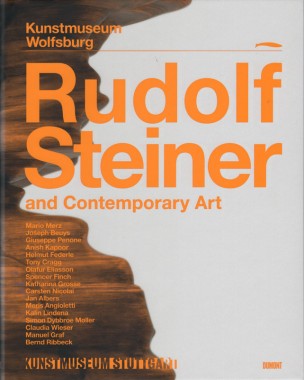
Markus Brüderlin and Ulrike Groos, Rudolf Steiner and Contemporary Art
Hardcover, 224 pp., offset 4/4, 240 x 315 mm
Edition of 5000
ISBN 978-3-8321-9278-5
Published by Dumont Buchverlag
$60.00 ·
At once a philosopher, educational and medical reformist, mystic and artist, Rudolf Steiner (1861-1925) was the founder of a spiritual movement he dubbed Anthroposophy, and of the famous school system that bears his name. Anthroposophy combined elements of German philosophy with Theosophical theory, and also made use of architecture, dance (Eurthymy), painting and sculpture to illustrate his ideas. Steiner’s artworks occupy a fascinatingly ambiguous status as both pedagogical and aesthetic entities, and served as springboards for the early work of Mondrian and Kandinsky among others; they have continued to influence artists down the generations. In 1992, Steiner’s panel drawings were exhibited at the Galerie Monika Sprüth in Cologne, renewing their efficacy for contemporary artists. Published for the Kunstmuseum Wolfsburg’s 2010 exhibition, this book is the first assessment of the influence of Anthroposophical thought on contemporary art.
Anish Kapoor, Anja Westermann, Anthroposophy, Architecture, Art, Bernd Ribbeck, Carl Kemper, Claudia Wieser, DAP, Double Standards, Dumont Buchverlag, Education, Galerie Monika Sprüth, Helmut Frederie, Holger Broeker, Jan Albers, Joseph Beuys, Kalin Lindena, Katharina Grosse, Kunstmuseum Wolfsburg, Manuel Graf, Mario Merz, Markus Brüderlin, Markus Mascher, Olafur Eliasson, Patricia Blankenhagen, Sarah Quigley, Spencer Finch, Stephanie Gotsch, Susanna Philippi, Tony Cragg, Ulrike Groos, Urlich Schwarz
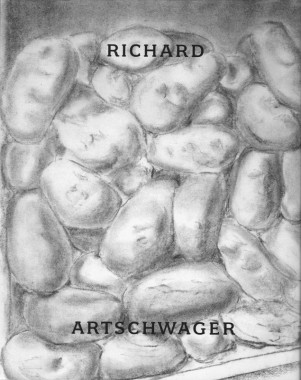
Richard Artschwager, Objects As Images of Objects
Hardcover, 128 pp., offset 4/1, 8.25 x 10.25 inches
Edition of 2000
ISBN 978-09771714-4-6
Published by David Nolan Gallery
$55.00 ·
Described variously as Minimalist, Conceptualist, Pop and (more recently) proto-Neo-Geo, Richard Artschwager’s art has long defied easy categorization, a sure sign that he has been doing something right. His career as a sculptor and draughtsman has playfully engaged issues of surface, material, object and function to pose repeatedly the Duchampian question: what constitutes an art object? Objects as Images of Objects is a 40-year survey of drawings in charcoal, ink and pastel, from the 1960s to the present, by an artist for whom drawing has remained primary, a spine of continuity throughout his many preoccupations. The diversity of imagery contained in these works on paper–including colorfully surreal landscapes and ambiguous shapes and objects that wreak havoc with cognition, sometimes floating on a sheet or arranged in different perspectives, other times taken from photographs and newspapers–reflect the artist’s highly idiosyncratic approach to image-making.
Alexi Worth, Art, DAP, David Nolan Gallery, Drawing, Richard Artschwager
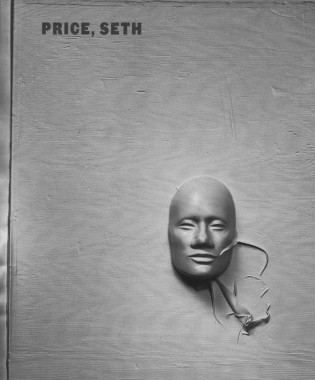
Seth Price, Price, Seth
Hardcover, 108 pp., offset 4/4, 200 x 240 mm
Edition of 2000
ISBN 978-3-03764-028-9
Published by JRP|Ringier
$35.00 ·
Through paintings, sculpture, video, and media work, Seth Price underlines the production strategies, dissemination modes, and valuation patterns of art. His appropriationist work, which he rather calls a “redistribution” of (often) pirated materials, disrupts the operations of commodity culture. Among his formats and tactics one should mention the recycling of iconic illustrations, reduplication (from digital to vacuum-formed techniques), the reenactment of projects, and the collaborative actions with
Continuous Project (formed in 2003 with Bettina Funcke, Wade Guyton, and Joseph Logan) or other artists.
The first monograph dedicated to the artist, this book includes an essay by Michael Newman as well as Price’s own critical take on his practice, given in the form of a videotaped conference that structures the presentation of his works.
Anja Nathan-Dorn, Art, Beatrix Ruf, Bettina Funcke, Clare Manchester, DAP, Farzad Owrang, Joseph Logan, JRP|Ringier, Kathrin Jentjens, Katy Homans, Kölnischer Kunstverein, Kunsthalle Zürich, Michael Newman, Richard G. Gallin, Sam Drake, Seth Price, Simon Vogel, Stefan Altenburger, Wade Guyton
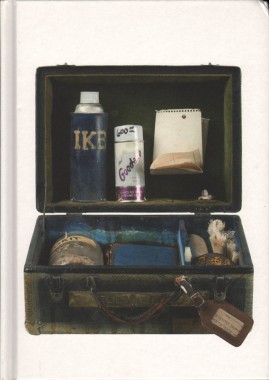
Robert Pincus-Witten and Rotraut Klein-Moquay, Yves Klein: USA
Hardcover, 204 pp., offset 4/1, 176 x 242 mm
Edition of 2000
ISBN 978-291627-564-2
Published by Editions Dilecta
$32.00 · out of stock
This book, produced in collaboration with the Yves Klein Archives, recounts the relationship between Yves Klein, one of the major artists of the postwar period, and the United States — a relationship of mutual fascination and reciprocal influence. Numerous documents, many of them previously unpublished, bear witness to the close ties that Klein forged with the U.S. The rising stars of the early 1960s American art scene (Robert Rauschenberg, Jasper Johns and Frank Stella, plus Marcel Duchamp) all make an appearance here, as does President Eisenhower! The book includes an interview with Rotraut Klein-Moquay, who talks about her trip to the United States with Yves Klein in 1961, as well as the artist’s comments on his own work. It also includes a hitherto unpublished essay by the American critic Robert Pincus-Witten, who met the protagonists of this story when he worked for dealer Leo Castelli.
In the spring of 1961, Yves Klein and his fiancee Rotraut Uecker, a distinguished artist herself, were en route to New York City. Leo Castelli, a leading American art dealer, had scheduled an exhibition of the work of “Yves le Monochrome” (as the painter had styled himself), to begin on April 11th. The exhibition marked Klein’s first solo show in the United States and its closing, set for the 29th of that month, virtually coincided with the artist’s thirty-third birthday, celebrated just the day before.
At the time, apart from the focus of a circle of fellow artists, noted critics and European dealers, a few alert collectors and many incensed detractors, Klein was still far from being recognized as the most influential artist to have emerged in postwar France — as he is regarded today; nor would one even dream that in scarcely more than a year he would be dead.
Art, DAP, Frank Stella, Jasper Johns, Leo Castelli, Marcel Duchamp, Robert Pincus-Witten, Robert Rauschenberg, Rotraut Klein-Moquay, Rotraut Uecker, Yves Klein
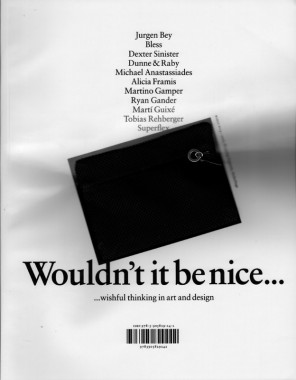
Katya Garcia-Anton and Emily King, Wouldn’t it be nice
Softcover, 300 pp., offset 4/1, 232 x 297 mm
Edition of 2000
ISBN 978-3-905829-24-2
Published by JRP|Ringier
$42.00 ·
Contemporary culture is witnessing one of the most significant shifts of recent times. The old dividing lines between artists and designers appear to be dissolving into one another. Indeed the breadth and range of investigation and inspiration they share is possibly the widest to date. This publication
Wouldn’t it be nice hopes to present a series of projects emerging from these lines of dissolution, which reflect the current spirit of cultural production internationally.
The publication includes interviews with Jurgen Bey, Bless, Dexter Sinister, Dunne & Raby and Michael Anastassiades, Alicia Framis, Martino Gamper, Ryan Gander, Martí Guixé, Tobias Rehberger, and Superflex. Fully illustrated, the book presents a number of projects that have been specially commissioned for the exhibition. Quoting the aesthetic of the glossy magazine, the publication is designed by London-based group Graphic Thought Facility, and has attached to each cover a Bless N°14–2000, Shopping Supports Stickerbags self-adhesive purse/multiple.
Alicia Framis, Art, Bless, Christian Brändle, Criticism, DAP, Dexter Sinister, Emily King, Fashion, Jean-Pierre Greff, JRP|Ringier, Jurgen Bey, Katya Garcia-Anton, Martí Guixé, Martino Gamper, Ryan Gander, Theory, Tobias Rehberger
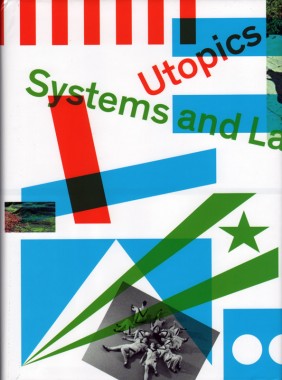
Simon Lamunière, Utopics: Systems and Landmarks
Hardcover, 160 pp., offset 4/4, 160 x 220 mm
Edition of 2000
ISBN 978-3-03764-056-2
Published by JRP|Ringier
$45.00 ·
This publication examines the spaces, nations, and communities created by artists or indivuals to develop alternative modes of living. Throughout history individuals have continuously developed systems based on a mix of reality, fiction, and mediatization, create micro-nations, or fight for their existence. All these proposals are simultaneously real and utopic. By inventing identity signs (IDs, flags, constitutions, currencies, etc.), by practicing their beliefs (be it through dance, naturism, terrorism, or collectivism), and by working on the boundaries of reality (parallel worlds, isolationism, new territories, etc.), these proposals are challenging our definitions of normalcy and territoriality. The title
Utopics is itself the free contraction of utopias, you, topic, topos, and pics.
Conceived as a glossary, the book includes artists such as Le Bélier, Carsten Höller, Clemens von Wedemeyer, Fabrice Gygi, General Idea, Lang/Baumann, Matt Mullican, Mai-Thu Perret, NSK (Irwin), Peter Coffin, Steiner & Lenzlinger, Superflex, as well as intitiatives such as La République Géniale (Robert Filliou), State of Sabotage (Robert Jelinek), micro-nations, L’Ecole de Stéphanie, etc.
Andrea Zittel, Anthroposophy, Architecture, Art, Betty Stocker, Buckminster Fuller, Carsten Höller, Clemens von Wedemeyer, Criticism, DAP, Fabienne Bideau, Fabrice Gygi, General Idea, Ildiko Dao, James Turrell, JRP|Ringier, Landmarks, Lang/Baumann, Le Bélier, Liam Gillick, Mai-Thu Perret, Matt Mullican, Nicolas Bourriaud, NSK (Irwin), Peter Coffin, Philippe Parreno, Photography, Pics, Pictures, Rirkrit Tiravanija, Rudoph Steiner, Simon Lamunière, Steiner & Lenzlinger, Superflex, Systems, Theory, Topic, Topos, Utopias, Waldorf
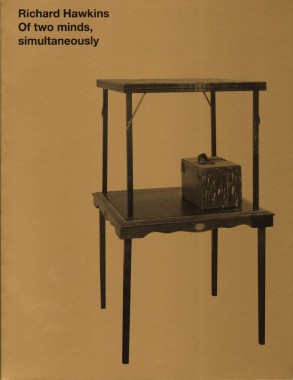
Richard Hawkins, Of two minds, simultaneously
Softcover, 164 pp., offset 4/1, 215 x 280 mm
Edition of 2000
ISBN 978-3-86560-425-5
Published by Walther König
$59.00 ·
This monograph on Richard Hawkins is published on the occasion of his first institutional overview exhibition with works from 1993 to now: starting with his collages from the 1990s — intriguing because they show how a powerful artwork can originate from very few visual means – right up to his recent dolls houses transformed into brothels that herald another completely new direction in Hawkins heterogeneous oeuvre. In his work Hawkins looks both critically and appreciatively at social, cultural and historical phenomena, mixing these with autobiographical motives to create a multiform body of work linked by countless internal references in ideas, material and style. These formal and internal links resonate throughout the whole book as components of themes that range from male desire, gender issues and pop star idolization to the struggle of mixedrace Native Americans or the function of hermaphrodite statuary in the Roman era.
Art, Bruce Hainley, Christopher Müller, DAP, Edna Van Duyn, Richard Hawkins, Walther König
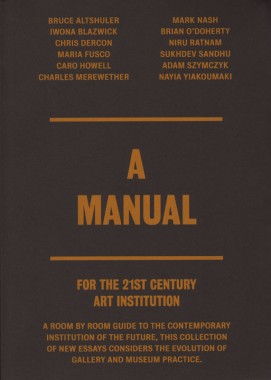
Shamita Sharmacharja, A Manual For the 21st Century Art Institution
Softcover, 184 pp., offset 2/2, 150 x 210 mm
Edition of 2000
ISBN 978-3-86560-618-1
Published by Walther König
$42.00 ·
A Manual For the 21st Century Art Institution invites 12 writers — artists, academics, curators and gallery and museum directors—to assess the present trajectory of arts institutions by explicating various issues, each of which is associated with an imaginary room. Readers journey from the reception to the roof terrace via rooms dedicated to temporary exhibitions, site-specific commissions and collections displays, taking in the bookshop, café, auditorium and education spaces along the way. Bruce Altshuler, Iwona Blazwick, Chris Dercon, Maria Fusco, Caro Howell, Charles Merewether, Mark Nash, Brian O’Doherty, Niru Ratnam, Sukhdev Sandhu, Adam Szymczyk and Nayia Yiakoumaki are our guides to this inviting theater. The result is an indispensable handbook for art professionals, students and anyone curious about today’s art world.
Adam Szymczyk, Art, Brian O'Doherty, Bruce Altshuler, Caro Howell, Charles Merewether, Chris Dercon, Criticism, DAP, Iwona Blazwick, Maria Fusco, Mark Nash, Nayia Yiakoumaki, Niru Ratnam, Shamita Sharmacharja, Sukhdev Sandhu, Theory, Walther König, Whitechapel Gallery
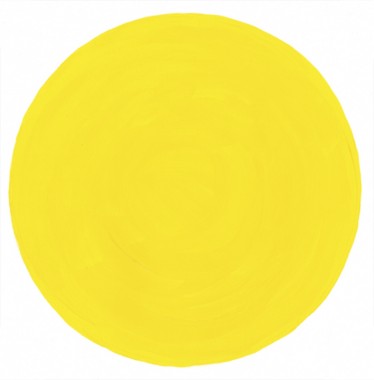
Cranfield and Slade, 12 Sun Songs
Hardboard/sleeve, yellow vinyl record + poster, offset 2/1, 315 x 315 mm
Edition of 2000
ISBN 978-3-03764-063-0
Published by JRP|Ringier, CK editions
$20.00 ·
Cranfield and Slade: 12 Sun Songs is a yellow vinyl album made up of covers of pop songs about the sun. Aping a 1970s concept album, Cranfield and Slade present twelve songs arranged to represent a day, beginning with songs about sunrise and winding down with songs about sunsets. Tracks range from classics such as George Harrison’s
Here Comes the Sun and The Kinks’
Waterloo Sunset, to the lesser-known
Sun by singer-songwriter Margot Guryan or
Where Evil Grows by Vancouver’s The Poppy Family. The album combines field recordings made in various Vancouver locations with electronic sound and acoustic and electric instruments. The liner notes for “12 Sun Songs” were written by celebrated Canadian poet and critic Peter Culley.
Based in rainy Vancouver, Cranfield and Slade is made up of visual artist Kathy Slade and artist/musician Brady Cranfield, working with musicians including Larissa Loyva (Piano, Kellarissa), Johnny Payne (Victoria Victoria, The Shilos), and Chris Harris (Piano, Parks and Rec, The Secret Three, Womankind); and special guests John Collins (The New Pornographers, The Evaporators) and artist Rodney Graham (The Rodney Graham Band, UJ3RK5).
Art, Chris Harris, Christoph Keller, CK editions, Cranfield and Slade, DAP, George Harrison, John Collins, Johnny Payne, JRP|Ringier, Larissa Loyva, Margot Guryan, Music, Performance, Peter Culley, Rodney Graham
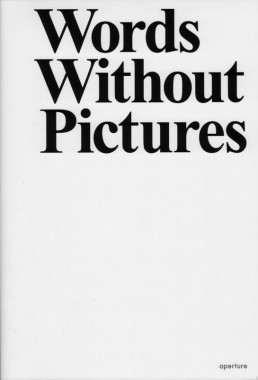
Alex Klein, Words Without Pictures
Softcover, 510 pp., offset 1/1, 5.75 x 8.25 inches
Edition of 2000
ISBN 978-1-5971114-2-3
Published by Aperture/LACMA
$25.00 ·
Words Without Pictures was originally conceived by curator Charlotte Cotton and artist Alex Klein as a means of creating spaces for discourse around current issues in photography. Every month for a year, beginning in November 2007, an artist, educator, critic or curator was invited to contribute a short unillustrated essay about an aspect of emerging photography. Each piece was available on the Words Without Pictures
website for one month and was accompanied by a discussion forum focused on its specific topic. Over the course of its month-long “life,” each essay received both invited and unsolicited responses from a wide range of interested parties. All of these essays, responses and other provocations are gathered together here. Previously issued as a print-on-demand title, we are pleased to present
Words Without Pictures to the trade for the first time as part of the
Aperture Ideas series.
A. L. Steiner, Alex Klein, Alex Slade, Allan McCollum, Allen Ruppersberg, Amir Zaki, Amy Adler, Anthony Pearson, Aperture, Art, Arthur Ou, Carter Mull, Charlie White, Charlotte Cotton, Christopher Bedford, Criticism, DAP, Darius Himes, David Reinfurt, Dexter Sinister, George Baker, Harrell Fletcher, James Welling, Jason Evans, John Divola, Kevin Moore, LACMA, Leslie Hewitt, Marisa Olson, Mark Wyse, Michael Queenland, Miranda Lichtenstein, Paul Graham, Penelope Umbrico, Photography, Sarah Charlesworth, Shannon Ebner, Sharon Lockhart, Soo Kim, Sze Tsung Leong, Theory, Walead Beshty, Wallis Annenberg Photography Department
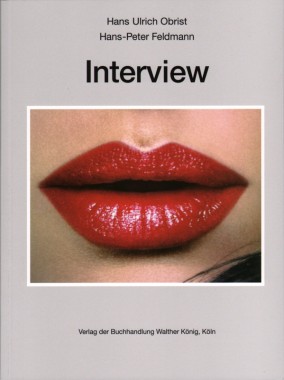
Hans Ulrich Obrist and Hans-Peter Feldmann, Interview
Softcover, 130 pp., offset 4/1, 165 x 220 mm
English and German
Edition of 2000
ISBN 978-3-86560-660-0
Published by Walther König
$49.00 ·
Hans Ulrich Obrist and Hans-Peter Feldmann, who have known each other for around 20 years, talked about the possibility of an interview for quite some time. They finally decided that Obrist pose the questions in writing, and Feldmann answer each of them with a picture.
Art, DAP, Hans Ulrich Obrist, Hans-Peter Feldmann, Interview, Photography, Pictures, Walther König
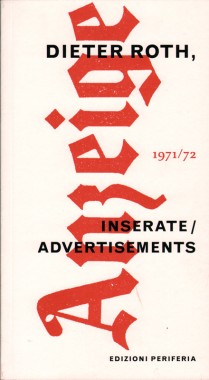
Dieter Roth, Inserate/Advertisements 1971/1972
Softcover, 156 pp., offset 2/1, 110 x 205 mm
English and German
Edition of 2000
ISBN 978-3-907474-77-8
Published by Edizioni Periferia
$19.00 · out of stock
Actionist, maker of objects, writer and graphic artist Dieter Roth created an exceptionally diverse and convoluted oeuvre. In Lucerne he published a series of small ads twice weekly in the newspaper Anzeiger Stadt Luzern und Umgebung, consisting of an aphorism and signed by his initials. Embedded in advertisements from real life, these ads conjured the surreal, subversive side of existence as in statements like “A good beginning is an evil end”, “A tear is as evil as a good word” and “Two tears are better than five stones”. The paper’s bourgeois readers raised such a protest over the disturbance of their peace by such enigmatic profundity that the paper felt compelled to terminate publication after 248 ads. From 1973 to 1979, Roth published his statements in artist’s books, titled The Sea of Tears (with the original pages of the newspaper) and Sea of Tears 1–5. This is the first complete, chronological publication of the ads, along with an English translation.
Art, Barbara Wien, Criticism, DAP, Dieter Roth, Edizioni Periferia, Stephan Fiedler
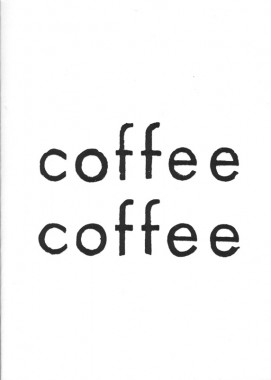
Aram Saroyan, Coffee Coffee
Softcover, 88 pp., offset 1/1, 5 x 7 inches
Edition of 1000
ISBN 978-0-9788697-5-5
Published by Primary Information
$10.00 ·
Infamous artist book by one of the 1960s most controversial poets.
Coffee Coffee was originally published as a mimeographed edition by Vito Acconci and Bernadette Mayer on their 0 To 9 press in 1967. True to Saroyan’s minimalist approach of the time,
Coffee Coffee’s pages contain one word (sometimes 2 and once or twice, 3), each pulling you to the next (revolving door-like). Selections from
Coffee Coffee appear in the recent anthology
Complete Minimal Poems (Ugly Duckling Presse) edited by Primary Information co-founder James Hoff; however, this is the first time that this work has appeared in its complete and initial form since 1967.
“In the late Sixties, when I called myself a poet, Aram was the poet I envied. Because you couldn’t be sure if he was fooling or if he had really gotten to all there is to get. Because while the rest of us tried to be verbs, like everybody told us to do, he had the nerve to stop at nouns. Because he took a deep breath and willed himself into the self-confidence of naming. Because it wasn’t ‘nouns,’ it was ‘noun,’ only one noun, because he boiled it all down to one. Because then he let himself go, he let himself stutter, he let the one go and let the one double and go out of focus: while the rest of us ran for our lives all over the place and over the page, his noun shimmered and breathed and trembled and moved-shh! softly, softly-from within.”
—Vito Acconci
Aram Saroyan, Art, Bernadette Mayer, DAP, James Hoff, Performance, Poetry, Primary Information, Vito Acconci












